Since seal script is an early form of writing, its basic strokes and brush usage methods are not as rich and complex as the official script and regular script that appeared later. As for large seal script and small seal script, there are only three writing methods: dot, straight and arc. Let’s take Deng Shiru’s works as an example to introduce the basic strokes of seal script as follows:
1 o'clock
There are fewer dots in seal script, and they are often connected with other strokes, as a part of other strokes, or extended into short horizontal or vertical strokes. There are fewer individual dots. The writing method is: start the pen from the center of the dot, rotate from left to right, and move the pen while turning until it turns into a circle and then close the pen. However, Deng Shiru's dots are extremely varied, and the dots of the same characters in the same work are treated differently. See (Figure 1) the different ways of writing the midpoints of the three characters "Tai".
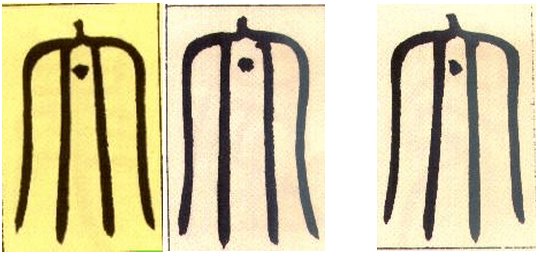
(Picture 1) Different ways of writing the three characters "Tai"
2. Straight
Straight includes long or short horizontal and vertical. The basic writing method is to hide the head and protect the tail, with the two ends rounded and the middle part of the same thickness. There are also a few horizontal or vertical ones that go in reverse and come out flat, revealing the front. Such as (Picture 1) the word "太". The horizontal and vertical lines of Deng Shiru's seal script are not all straight lines. Except for the vertical straight line in the center, the horizontal lines are often slightly arc-shaped. Very dynamic. Its brushwork can be seen from the horizontal drawing of the character "上" and the horizontal drawing of the character "十" in (Figure 2).
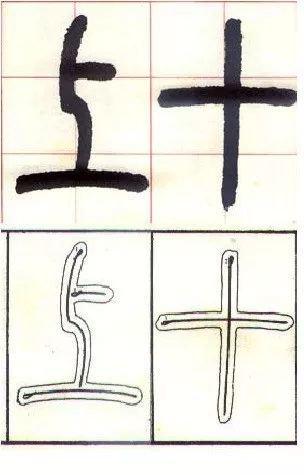
(Picture 2) Top ten
3. Arc
Arcs in seal script can be divided into angular arcs, semicircular arcs, circular arcs, square arcs and irregular arcs. Except for some irregular arcs, arcs are written with two strokes, taking arcs as an example; the method of writing is basically the same as the horizontal or vertical strokes. The stroke is drawn from the top of the circle to be written, and the semicircle is written to the left first. Then draw a semicircle from the top of the stroke to the right, and meet at the bottom of the circle, leaving no trace at the intersection. (Picture 3) The two arcs in the upper part of the character "大" and the two arcs in the lower part of the character "Zhu" are both written in two strokes. (Picture 4) The arc above the character "月" is written in two strokes, the irregular arc in the lower part of the character "月", and the arc of the character "多" are written in one stroke.
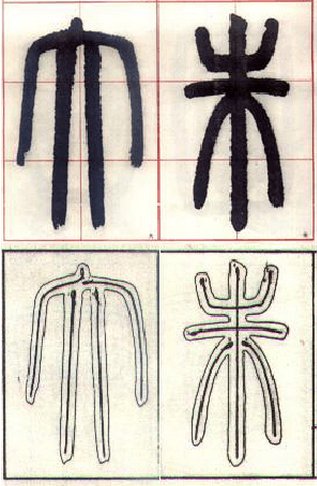
(Picture 3) Da Zhu
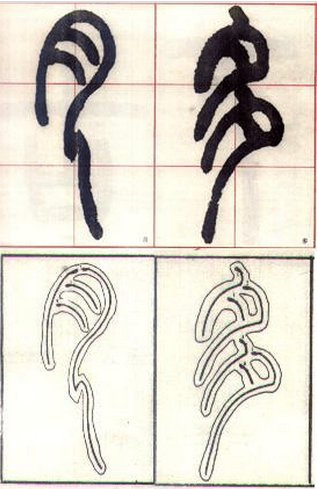
(Picture 4) More than a month
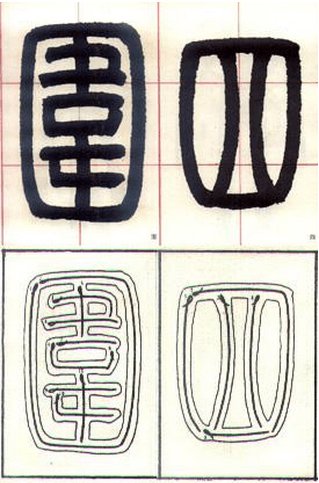
(Picture 5) Wai Si
(Figure 5) The outer frame of the characters "wai" and "四" can be divided into two strokes or three strokes. Although it is an outer frame, it is also curved.
2. How to start and end Deng Shiru’s seal script:
Go backwards, stop and close, and pay attention to restraint and subtlety; or go in reverse and go out flat, relaxed and smooth. The two ends of the painting are rounded, like the two upper parts of the character "公" (Figure 6). Go in reverse and come out flat. The starting stroke is round and thick, and the ending stroke is slightly pointed, like "Tai" (Figure 6). However, the seal script is still mainly hidden, and occasionally exposed to show the spirit.
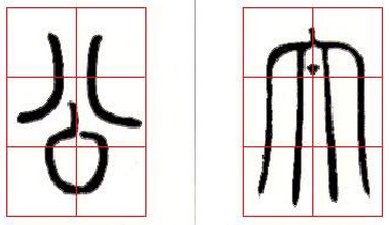
(Picture 6) Gongtai
3. How to use pen:
In the curving strokes, you may use the method of lifting and turning to see the roundness; you may use the method of stopping first and then turning to see the outer circle and the inner square; or you may use the method of sudden folding to see the square strength. (Picture 7) The upper part of the character "back" is curved using the method of stopping first and then turning; the lower part of the character "back" is curved using the method of lifting and turning. (Picture 7) The bending method of the word "ji" is often used. However, multiple methods are often used in one word.
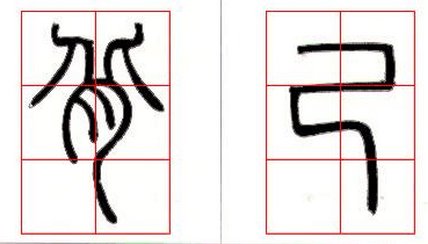
(Picture 7) Betrayal of oneself
4. How to deal with line relationships:
1. Parallel relationship: Straight lines in seal scripts are usually processed in a parallel way, such as (Figure 8) the horizontal drawings of the word "义". These horizontal drawings are not really straight, but also arc-shaped. Curved lines in seal scripts are sometimes processed using parallel methods, such as the curves in the upper left and upper right parts of the character "道" (Figure 8).
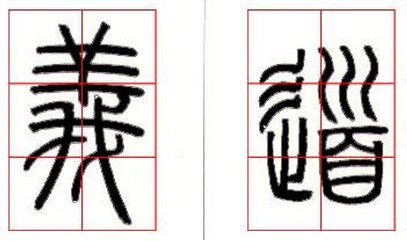
(Picture 8) Yidao
2. The relationship between hugging and backing each other: The curves in seal scripts are often dealt with by hugging and backing each other. For example, in the character "来" (Figure 9), the curves to the left and right of the straight line are arranged in an embracing relationship; while (Figure 9), the curves around the character "empty" are arranged in opposite directions. They are often used side by side to complement each other. For example (Figure 10), the outer two curves of the character "ER" embrace each other, the inner two curves are opposite to each other, and the two left curves and the two right curves form an embrace relationship respectively. (Picture 10) The curves in the lower part of the character "篆" form the wonderful idea of backing each other and embracing each other respectively.
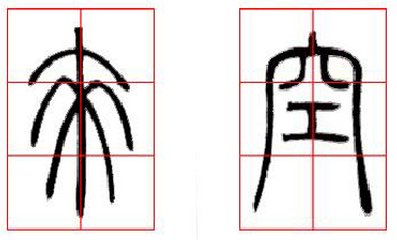
(Picture 9) Lai Kong
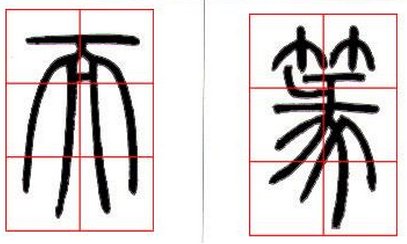
(Picture 10) Erzhuan
3. Staggered relationship: When there are two or more drooping lines in seal script, attention should be paid to the staggered changes of the drooping legs. For example (Figure 11), the word "白" has only two hanging legs, but they are also different in height. Another example is (Figure 11) the varying changes in the four vertical legs of the character "雁".
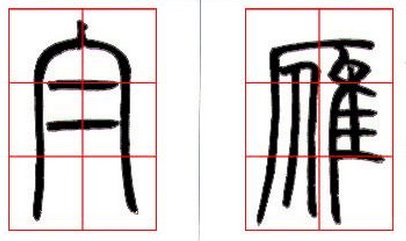
(Picture 11) White Goose
4. Symmetrical relationship: The symmetrical treatment of lines is an important feature of seal script. For example (Picture 12) the characters "bu" and "go"; (Picture 3) the characters "da" and "zhu". Although it is symmetrical, it is not absolutely the same on both sides. We can still see the changing and dynamic symmetry.
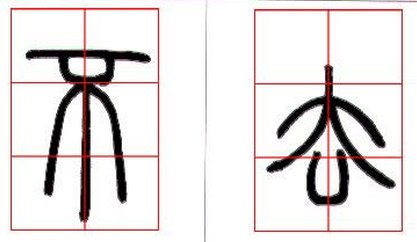
(Picture 12) Not going
5. Method of cloth whitening
1. Uniformity: Uniformity is what we strive to pursue in seal script cloth. The methods of parallelism and symmetry in lines are closely related to this. For example (Figure 13), the spaces between the horizontal lines of the word "quantity" and the spaces to the left and right of the middle line are almost the same. And (Picture 13) between the upper horizontal strokes of the word "Nai" and the lower left and right spaces are almost the same.
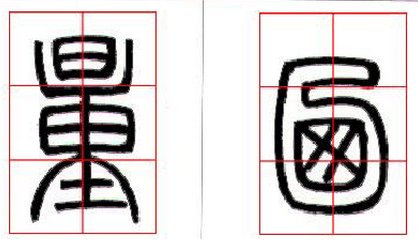
(Picture 13) Liang Nai
2. Dense at the top and sparse at the bottom: Seal script not only pays attention to the uniformity of white space between lines, but also pays attention to changes in density. In most cases, Xiaozhuan is arranged in a dense pattern at the top and sparse at the bottom. For example (Figure 14), the words "心" and "黄" are both dense at the top and sparse at the bottom.
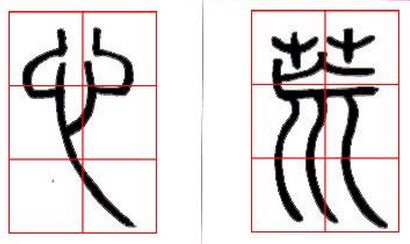
(Picture 14) Heart desolation
3. Sparse at the top and dense at the bottom: Some characters in seal script have strokes that stretch upward. In this case, in addition to the uneven changes in the upward stretching strokes, the whitening process is all done with sparse at the top and dense at the bottom. method. Such as (Figure 15) the word "zhi" and the word "shi".
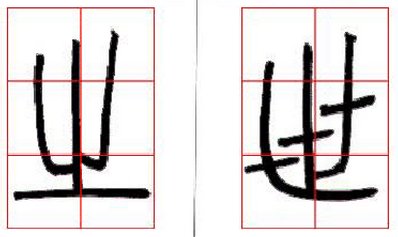
(Picture 15)
6. Structural methods;
1. Give in: (Figure 16) "Evil" and "Stupidity" are upper and lower structures. If they are not handled well, it is easy to feel that upper and lower are separated. When working with the structure, the upper part expands outwards to allow the lower part to enter, so that the top and bottom are integrated.
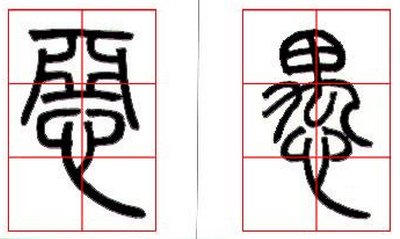
(Picture 16) Evil fool
2. The left part is high and the right part is low: the left part only has strokes that can be extended upwards, and the right part has strokes that can be extended downwards, such as (Picture 17) the word "cicada"; or there are strokes on the left part that can be extended upwards and downwards, but the left part can only be drawn downwards. A stretched painting, like the word "good". In this case, the left and right positions are usually treated as high on the left and low on the right.
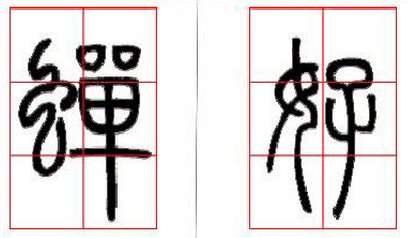
(Picture 17) Hello cicada
3. The left is low and the right is high: the left part has only lines that can be extended downward, and the right part has only lines that can be extended upward, such as the word "zhao" in (Figure 18), or the left part has lines that can be extended up and down, and the right part has only lines that can be extended upward. Lines that can only be extended upward, such as the character "物" (Figure 18). Usually the left and right positions can be arranged so that the left is low and the right is high.
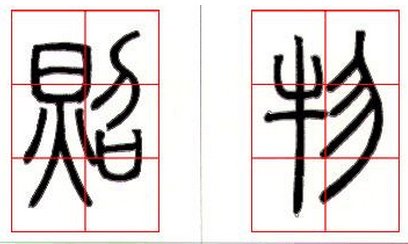
(Picture 18) Photo object
4. Left-centered: There is no painting extending up and down on the left, but there is a painting stretching up and down on the right, such as (Picture 19) with the word "Zui"; or there are paintings extending up and down on both the left and right, but the left part is slightly smaller than the right part, such as (Picture 19) Figure 19) The word "jing". In this case, the left and right positions are usually treated as left-center.
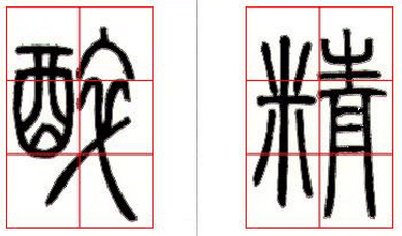
(Picture 19) Drunk Essence
5. Shangping: The left part is small and has no hanging legs, while the right part is large and has hanging legs. The left and upper positions are usually used, such as (Figure 20) with the characters "氰" and "明".
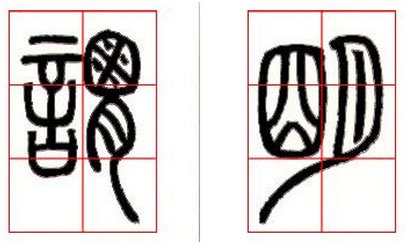
(Picture 20) It’s clear
If you encounter words with a left-center-right structure, you must flexibly use the positioning method. For example (Figure 21) for the word "Qing", the left and middle parts are placed on the left side, while the middle and right parts are placed on top. As for the word "avoid" (Figure 21), the left part and the middle right part take the position of high on the left and low on the right, and the middle and right parts take the position of flat upward.
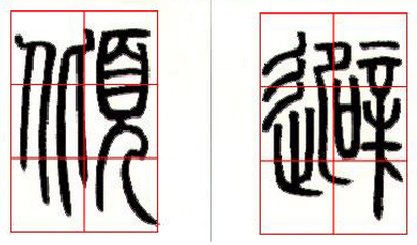
(Picture 21) Avoidance
6. Fully surrounded by a quadrangular shape: The word "wai" in (Figure 5) has numerous horizontal paintings that neatly divide the space, making the blank space comfortable and bright. This is also extremely important in the structure of seal script. (Figure 5) The two vertical strokes within the character "四" curve outward in a back posture, contrasting with the vertical strokes on the outside, and are gathered together by the horizontal strokes at the bottom. The strokes are graceful and lively.
In summary, the seal script writing techniques introduced above are not only the universal rules of seal script, but also the seal script writing techniques developed by Deng Shiru. Only by understanding various styles of seal script can we appreciate Deng Shiru's true contribution to the development of seal script.
Copyright statement: The above pictures and texts are from the Internet. The copyright belongs to the original author. If there is any infringement, please contact us and delete it.








